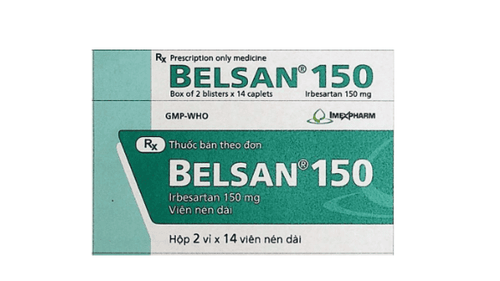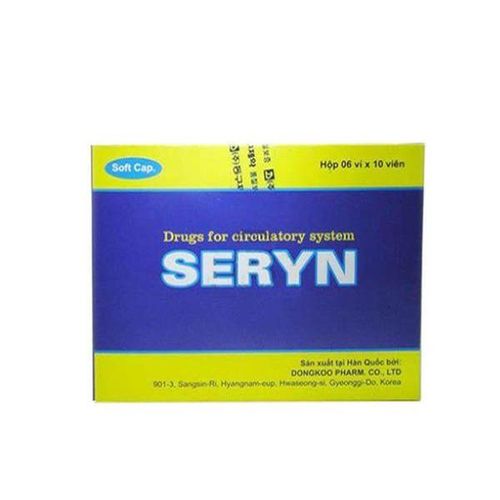This is an automatically translated article.
Daeladin is a calcium channel blocker, indicated for the treatment of hypertension alone or in combination with other antihypertensive agents. Readers refer to the article below to know what Daeladin is and how to use it?1. What is Daeladin?
Daeladin has the main active ingredient Lacidipine 4mg, is a calcium channel blocker, used in the treatment of hypertension alone or in combination with other classes of antihypertensive drugs (beta-blockers, diuretics and inhibitors). ACE inhibitors).
Daeladin drug is prepared in the form of film-coated tablets, content of 4mg.
Daeladin has a strong calcium channel blocker, belongs to the dihydropyridine group and is highly selective for calcium channels in vascular smooth muscle. The main effect of Daeladin is to dilate peripheral arterioles, reduce peripheral vascular resistance and thereby reduce blood pressure.
2. Indications of the drug Daeladin
Daeladin is indicated for use in the following cases:
Primary hypertension. Secondary hypertension. Raynaud's syndrome.
3. Contraindications of the drug Daeladin
Daeladin is contraindicated in the following cases:
Patients with a history of allergy, hypersensitivity to Lacidipine or to any of the ingredients. Patients with severe aortic stenosis. Patient in cardiogenic shock. The patient had a history of myocardial infarction within 1 month. Unstable angina.
4. Dosage and how to use Daeladin
4.1. How to use the drug Daeladin Daeladin is made in the form of film-coated tablets with a concentration of 4mg Lacidipine each, for oral use. Before taking Daeladin, the patient should have a doctor's prescription and carefully read the drug information on the instruction sheet. Should take the medicine in the morning, at a fixed time of the day to avoid forgetting the dose.
4.2. Dosage of Daeladin The dose of Daeladin is adjusted based on the severity of the condition, the patient's response to medication, and under the supervision of a physician. The dose of Daeladin below can be referred to:
Adults:
The recommended starting dose is: 2mg/time x 1 time/day. After 3-4 weeks of use, if the patient does not respond, the dose of Daeladin can be increased to 4mg/day (maximum dose 6mg/day). Doses > 6mg per day have not been shown to be significantly more effective. Children: The safety and effectiveness of Daeladin in children and adolescents under 18 years of age have not been established.
Patients with severe renal impairment: Use the usual adult dose, no dose adjustment required. However, regular blood tests of kidney function are required.
5. Undesirable effects of the drug Daeladin
Common undesirable effects of Daeladin are as follows: Body and skin: Rash, erythema, pruritus, edema of the lower extremities and increased alkaline phosphatase. Nervous system: Headache, dizziness and palpitations. Cardiovascular system: Increased heart rate response causing tachycardia and flushing Gastrointestinal system: Abdominal discomfort and nausea. Urinary system: Polyuria. Uncommon side effects of Daeladin are as follows:
Syncope, hypotension and gingival hyperplasia. Rare side effects of Daeladin are as follows:
Anaphylactic reactions, angioedema, urticaria, cramps, angina and hypotension. If you experience these symptoms, the patient should stop using Daeladin and notify the doctor for appropriate treatment.
6. Be careful when using the drug Daeladin
Patients using Daeladin should note the following information:
Daeladin should not be used in patients with a history of previous allergic reactions to another calcium channel blocker because of the risk of cross-reactivity on theory. Use Daeladin with caution in patients with a history of sinus node and atrioventricular node abnormalities because of the risk of cardiac arrhythmias. Daeladin should be used with caution in patients with cardiac arrhythmias (electrocardiograms with QT prolongation) and in patients treated concomitantly with drugs known to prolong the QT interval such as class I and III antiarrhythmic agents. , tricyclic antidepressants, some antipsychotics, antibiotics (eg erythromycin) and some antihistamines (eg terfenadine). Patients with impaired liver function, hepatic impairment: As with all other calcium channel blockers, the elimination time of Daeladin is prolonged in patients with impaired liver function and there is no recommended dose for these patients. Therefore, Daeladin should be used with caution in these patients. During use, it is necessary to periodically test liver enzymes. For pregnant women: There are no data on the safety of Daeladin in pregnant women. Therefore, Daeladin should only be used during pregnancy when prescribed by a doctor when there is no safer alternative. For lactating women: There are some experimental studies showing that Daeladin is likely to be excreted in human milk. Daeladin should be used during breast-feeding only when the potential benefits to the mother outweigh the potential for adverse effects in the infant. Caution when driving and operating machinery: Daeladin may cause dizziness. Therefore, patients should not drive or operate machinery while taking the drug, especially when headache, dizziness or related symptoms are present. Daeladin is used to lower blood pressure in patients with primary and secondary hypertension. Note, Daeladin is a drug prescribed by a specialist, patients absolutely cannot use it on their own. Patients should be advised on how to monitor their blood pressure at home for the purpose of self-monitoring their health status and assessing the effectiveness of medication when used for a long time.













